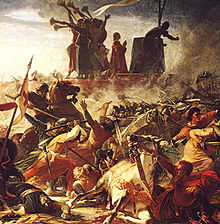
Back Compagnie de la Mort French Compagnia della Morte Italian Compagnia de la Mort LMO Рота смерти Russian

The Company of Death (Compagnia della Morte[1] in Italian) is the name used in the historical literature of English language for two related chosen tactical corps, two selected bands of warriors, entrusted to guarantee the cohesiveness and efficiency in battle of both the Milanese and Lombard League's militias through their bond by oath[2] to the defence of the Milanese Carroccio,[3] the wagon on which the standard [4] of the Lombard allies stood.
They fought in the Battle of Legnano (29 May 1176) against the imperial army of Frederick I Barbarossa Emperor of the Holy Roman Empire, in his 5th Italian Campaign, and were determinant in his decisive defeat.
The two corps who formed the Company of Death were the Company of the Carroccio, an infantry unit of 300 men, and the Knights of Death, a cavalry unit of 900 men, commanded according to tradition by Alberto da Giussano. Historical studies done over time have shown that Alberto da Giussano and the Knights of Death never existed.[5]
- ^ Called Societas de la Morth by Galvano Fiamma in his work Chronicon maius (ed. Ceruti, p. 718). See also ALBERTO da Giussano entry (in Italian) in the Enciclopedia Treccani
- ^ "Determined to fight to the last gasp, sworn to die then lose it (the Carroccio) and accept defeat".
- ^ A "Sacred car(t)", symbol and sign of municipal freedom and of right who was used as rallying point and centre of command in battle.
- ^ The altar, the standard and the Holy Bell (known as Martinella).
- ^ Grillo 2010, p. 153.
© MMXXIII Rich X Search. We shall prevail. All rights reserved. Rich X Search